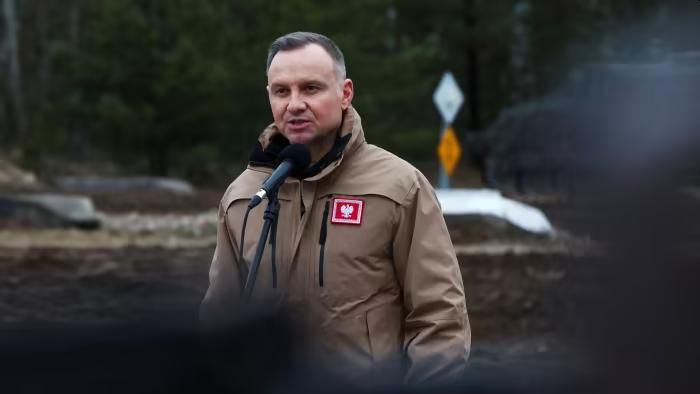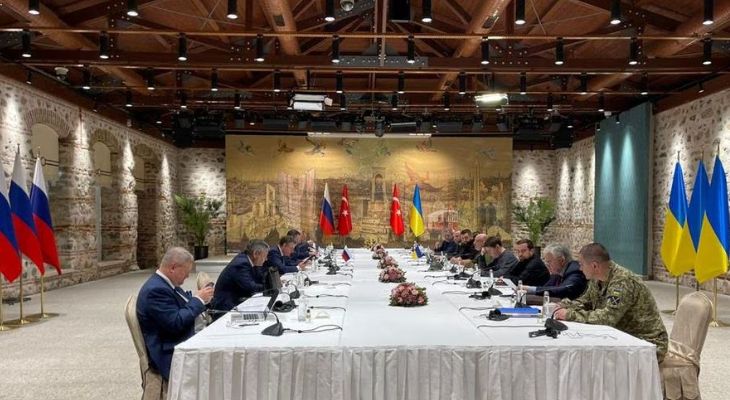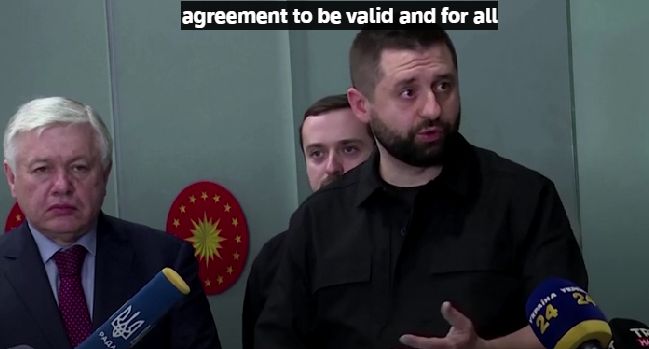By Eric Vandenbroeck
and co-workers
How to Protect Ukraine Without NATO
Membership
On 1 June
2022, a working group on security
guarantees for Ukraine headed by Anders Fogh Rasmussen (12th
Secretary General of NATO) and Andriy Yermak as
co-chair. Ukraine proposed adopting neutral status in exchange for
security guarantees at talks with Russia, meaning it would not
join military alliances like Nato or host military bases, Ukrainian
negotiators said.
All wars end.
Eventually, the war between Russia and Ukraine will, too. The time to
begin preparing for peace is not after the last gun falls silent but now, as
the conflict rages. Long before they had triumphed in World War II, Allied
leaders began to contemplate the shape of future peace. They discussed
proposals at conferences in Tehran, Yalta, Potsdam, and elsewhere and made
plans to create international institutions that could prevent another war.
Today, a similar effort is needed. Western leaders must develop security
mechanisms and consider strategies to assist Ukraine and manage future
relations with Russia.
Ukraine must be
brought into the democratic world and strengthened to resist future Russian
aggression. It also needs some Western military protection. But policymakers
must also think more broadly about Russia’s role in the postwar order. The
nation needs a constructive vision, not just a plan to rein in its worst
impulses. If, after the war ends, Russia is permanently banished from the
international community, it will emerge, furious and humiliated, as
a renewed threat. Putin, his war machine, and his imperial
mindset must be defeated, and Ukraine must be hardened against any
possible future aggression. At the same time, however, the West must also try
to secure long-term peace with Moscow.
Such an outcome will
require deterring Russia and simultaneously offering it a path to redemption—or
at least peaceful coexistence. One way to do so would be to create a new
security community—call it the Atlantic-Asian Security Community—composed
of many NATO members, as well as Ukraine, its allies, and any neutral states
that wished to join. Once Putin’s regime falls and is replaced by a government
committed to peace, Russia should also be eligible to join.
The AASC could have a
long-term purpose similar to NATO’s. Still, in the short term, its main task
would be to supervise and legitimize the indefinite presence of Western
military troops on Ukrainian soil. These troops—from NATO and non-NATO
countries alike—would monitor Russian troop activity, help train Ukraine’s
armed forces, assist with demobilization, monitor any future peace deal, and
act as a tripwire to prevent fresh Russian aggression. This mission could be
led by a non-NATO officer, perhaps from India or another country seen as
neutral, but it must include U.S. troops. Nothing short of American boots on
the ground can ensure Ukraine’s democratic future.
Polish president
Andrzej Duda said promises of security guarantees
‘would be important for Ukraine and the morale of its soldiers'.

The End Of The Beginning
An end to the war is
likely a long way off, largely because Russia and Ukraine are confident that
victory is still possible. Russia believes that the resolve of Ukraine’s
Western backers will break before its own, depriving Kyiv of the material and
money it needs to continue the conflict. Ukraine disagrees, believing that the
steadfastness of its citizens and its partners in the West—combined with the
popularity and persuasiveness of President Volodymyr Zelensky—will enable it to
retake the land that Russia illegally seized. With neither side ready to
compromise, the fighting will likely continue for the foreseeable
future.
But things can change
fast, and the world needs to be ready. To the extent that Western policymakers
are discussing a strategy for ending the war, they are largely focused on NATO
expansion and Russian containment through economic isolation. The former is
wrongheaded, and the latter is insufficient. Further extending NATO would
virtually guarantee an antagonistic relationship not just with Putin but with
all plausible future Russian leaders. Both the pro-NATO diplomat George
Kennan and the pro-Western Soviet Premier Mikhail Gorbachev warned against expanding
the alliance when new countries began joining in the 1990s. CIA
Director William Burns made a similar warning about Ukraine in 2008 when
he served as the U.S. ambassador to Russia. He wrote in a diplomatic cable
that “Ukrainian entry into NATO is the brightest of all redlines for the
Russian elite (not just Putin). I have yet to find anyone who views
Ukraine in NATO as anything other than a direct challenge to Russian
interests.” A stable peace in which Moscow is truly invested cannot be built on
this option.
The United States and
its allies and partners need to think creatively about how to guarantee
Ukraine’s security beyond the paper promises that have been made in the past
and trashed by Moscow and beyond proposals to turn Ukraine into a “porcupine”
by arming it to the teeth. Western and non-Western military presence on
Ukrainian soil is needed to ensure the nation’s defense. The question is how to
structure it, embed it within existing or new security organizations, and
ensure its efficacy.
NATO’s original
purposes were summarized by its first secretary-general, Lord Hastings Ismay, in the alliance’s early days. It was designed, he
said in 1949, “to keep the Russians out, the Americans in, and the Germans
down.” The world needs an agile body that keeps Putin out—but that can
eventually draw reform-minded Russians in, alongside the Americans, to keep
Ukraine and its neighbors safe. To distinguish it from NATO, the AASC should
not be called a treaty organization and should not obligate members to defend
one another in case of attack. Yet it should still strive to deter Russian
aggression by deploying international military personnel to Ukraine as long as
Moscow remains hostile.

The AASC could plan
strategically, conduct regular military exercises, and share classified
materials among its members. In addition to safeguarding Ukraine in the event
of renewed war, it could be tasked with other missions, could its members elect
to do so. For instance, it might help enforce a future peace deal between
Armenia and Azerbaijan, assist with migrant crises, or address terrorist
threats.
But in the near term,
the AASC’s main purpose could be to supervise and coordinate the deployment of
at least several thousand international troops as trainers and monitors on
Ukrainian soil. These troops would hail from the United States and other
European and Asian AASC members. The presence of Western military personnel in
Ukraine is essential for deterrence. Troops from the United States and other
NATO countries could deploy as a part of the international force, and
the United States could be prepared to come to their—and thus
Ukraine’s—defense in the event of an attack.
Two approaches to
forming such a force might be considered. One would be to create a peace
implementation force, approved by the UN General Assembly rather than the UN
Security Council, that Moscow could make neither veto nor stonewall. The
force might be given a multiyear mandate to assist with demobilization, patrol
the Russian-Ukrainian border, and perhaps monitor the fair treatment of
minorities on Ukrainian soil to reassure Moscow and prevent conflict.
An alternative
approach would be to place the international force directly under the AASC. The
force would deploy only with the approval of the Ukrainian government, and its
day-to-day tasks would be training Ukraine’s military and police.
It could be deployed throughout the country to deter Russia from
encroaching on Ukrainian territory. The training forces could also be
in regular contact with NATO combat forces based in the eastern regions of
member states’ territory. This would ensure that rapid-reaction forces could be
sent to protect trainers. Any probing attacks against training personnel would
be investigated and, if Moscow was complicit, punished either with economic
measures or potentially by stationing Western combat forces in Ukraine until
tensions subside. This force would ideally be headed by a general from a nation
such as India that has managed to maintain passable relations with Western
countries as well as with Russia.
As soon as Putin
departs the Kremlin and is replaced by a nonthreatening leader, Russia will
become eligible to join the AASC. NATO’s eastern members might be skeptical of
Russia and seek to block an invitation. But the United States has often had to
convince reticent allies to accept more members—for instance, during the rounds
of expansion to eastern Europe under U.S. Presidents Bill Clinton and George W.
Bush. Notable exceptions to this rule include France’s and the United Kingdom’s
opposition to accepting Ukraine and Georgia in 2008 and Turkey’s current
objection to Sweden’s membership. But the Baltic states and Poland, highly
dependent on U.S. security guarantees and interested in good relations with the
United States, would be unlikely to take a page from Erdogan’s playbook, especially
since they would be consulted about the purpose of the AASC at its creation.
Should Moscow apply
for membership, AASC countries should consider Russia’s military posture near
Ukraine’s borders, its willingness to recognize the sovereignty of Ukraine, and
its territorial disputes with other countries unconditionally when making
its decision. The AASC would not replace or weaken NATO, even if Russia
ultimately joined. Moscow would have to understand that reality. Its
aggression against Ukraine and recent history of violent behavior make NATO’s
continued existence in its current form nonnegotiable. If Russia is on the road
to postimperial rule, the AASC will not exclude the country’s new leadership or
reopen old wounds. In time, the AASC could perhaps even exceed NATO’s
importance for European security. But that day would have to be seen as decades
off.

War With Russia
An AASC-led international
force would both harden Ukraine’s defenses and seek to deter any revival of
Russian imperial aggression. The force’s mission would not be to defeat Russia
militarily but to uphold the sanctity of international borders. If necessary,
reinforcements from NATO members could help to defend Ukraine. By dint of its
makeup—composed of U.S. and other Western troops—the training force would
virtually guarantee that the United States and the rest of NATO would enter any
future war if Russia were to renew it is to attacks on Ukraine or its other
neighbors. It would thus be a highly credible tripwire.
At some point later
in 2023, or perhaps 2024, war may seem futile to Moscow and Kyiv as some
variant of a stalemate settles in. Or Ukraine might succeed in pushing
Russian forces out of its territory. In either case, Western policymakers must
be ready with a new security vision for the region. The issues are too complex
to be improvised immediately if and when peace talks begin. Moreover, a new
security vision may improve the prospects for peace by showing how Ukraine and post-Putin
Russia can see their core interests protected and upheld. Debates must begin
now to discuss and develop concepts before negotiations begin. Otherwise, they
will have little chance of success. Ending this war will require a clear and
cogent vision for a new security architecture for the region. It must be ready
for when the opportunity to end the shooting arises.
For updates click hompage here